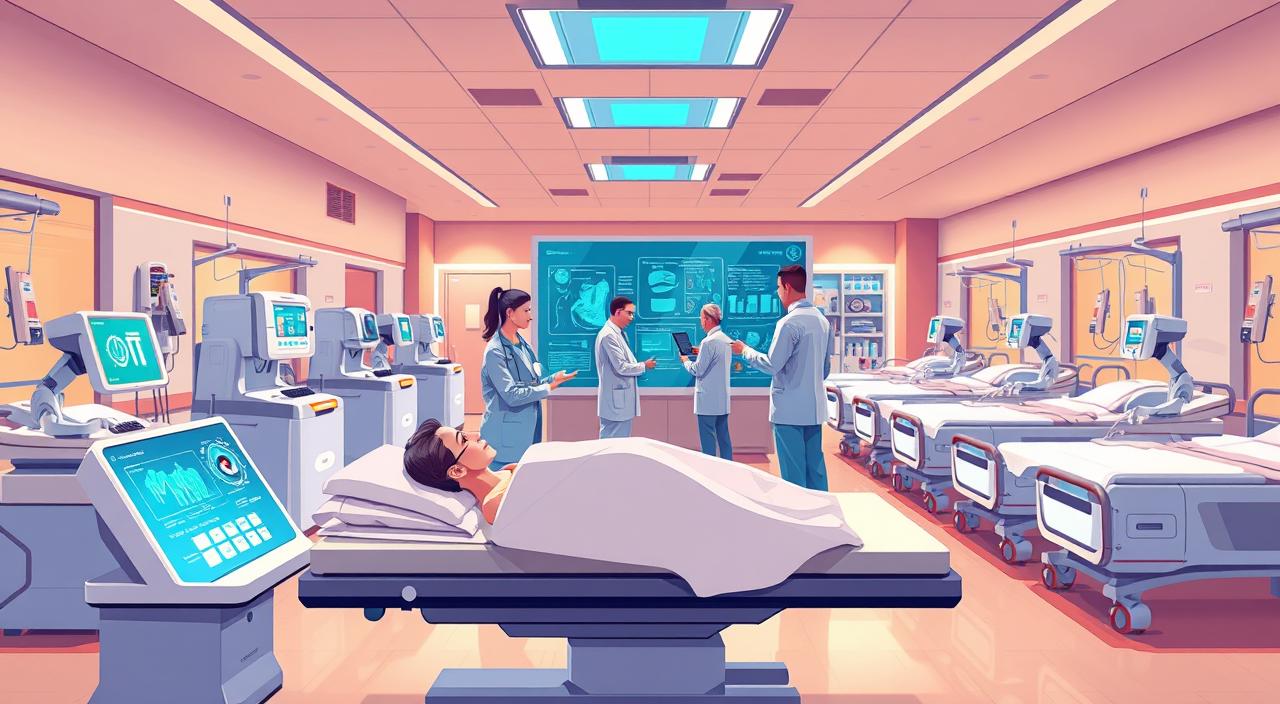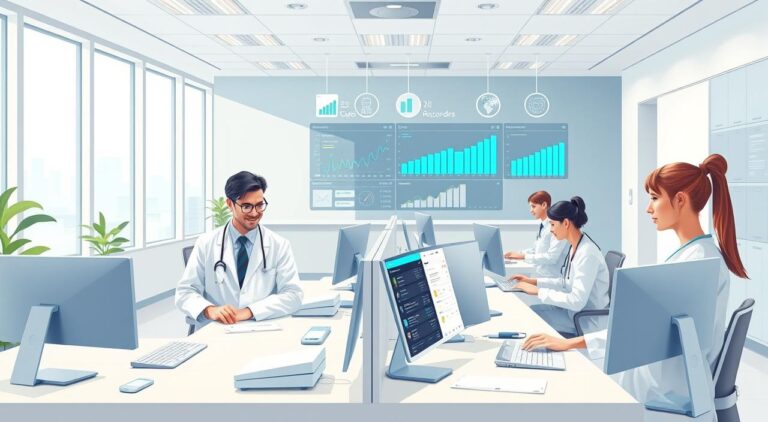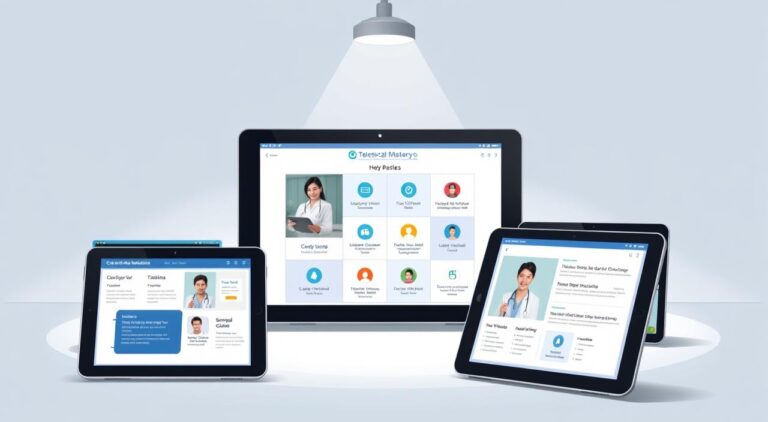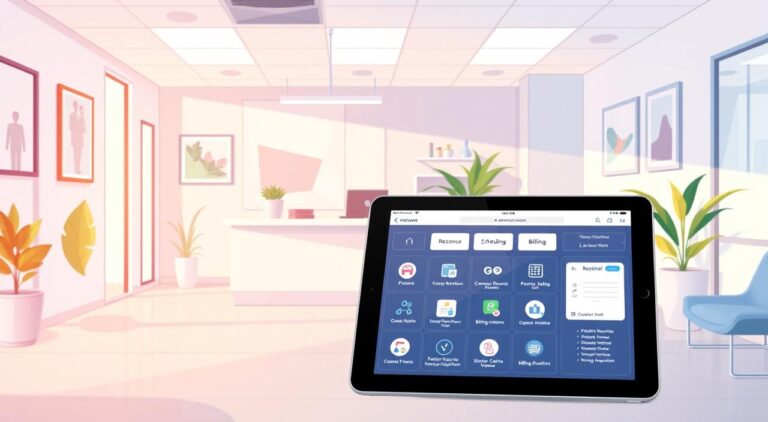AI Healthcare Tools Improving Patient Care in America Explained
Artificial intelligence is reshaping the entire medical landscape for millions of people. These advanced systems represent one of the most significant technological advances in modern medicine.
Many Americans face critical challenges with affordability and access. One-third find their health services unaffordable. Nearly half of those with serious conditions delay necessary treatment due to financial barriers.
This creates an urgent need for innovative solutions. Intelligent technology now provides unprecedented opportunities to address these issues. It improves diagnostic accuracy and reduces costs while enhancing outcomes.
Leading voices from major tech companies recognize this transformation. They see medical applications as perhaps the most pressing use for this powerful technology. The focus remains on augmenting human expertise to ensure compassionate, personalized care.
This analysis explores how these systems are implemented across various areas. We will examine precision diagnostics, remote monitoring, and personalized treatment plans. The information draws from peer-reviewed research and real-world clinical applications.
Key Takeaways
- Advanced technology systems are transforming medical delivery across the United States.
- Affordability and access remain significant challenges for many Americans.
- Intelligent systems offer solutions by improving accuracy and reducing costs.
- This technology augments human expertise rather than replacing it.
- Real-world applications include diagnostics, remote monitoring, and personalized plans.
- The information is based on peer-reviewed research and FDA-approved technologies.
Understanding the AI Revolution in Healthcare
The integration of sophisticated computational systems into medical practice marks a pivotal shift. It challenges long-held conventions in how we deliver and experience health services.
This technology represents a genuinely disruptive force. It offers concrete solutions to problems that have plagued systems for decades. These include critical workforce shortages and inconsistent patient outcomes.
The power of this innovation lies in its unique capabilities. It processes vast amounts of data from records, imaging, and genomics. This allows it to identify patterns impossible for humans to discern manually.
AI as a Disruptive Force in Medicine
By 2030, global systems could face a shortage of 18 million professionals. This makes intelligent augmentation essential for maintaining quality and access. The technology directly addresses the industry’s core challenges.
The ‘quadruple aim’ of modern medicine—improving population health, enhancing the patient experience, supporting caregivers, and reducing costs—is now within closer reach through these advanced systems.
Key Benefits of AI Integration for Patient Outcomes
The benefits for individuals are profound. Earlier disease detection through pattern recognition leads to timely intervention. More precise diagnostic accuracy significantly reduces misdiagnosis rates.
These systems enable highly personalized treatment plans. They are based on a patient’s unique characteristics and data. Predictive analytics can also identify high-risk individuals before a health crisis occurs.
Machine learning algorithms continuously improve with more data and physician feedback. This creates increasingly accurate and valuable tools over time. Authoritative research validates that these systems can match or exceed human expert performance in areas like radiology and pathology.
Ultimately, this intelligence augments human medical expertise. It allows physicians to focus on complex decision-making and compassionate care. The systems handle time-consuming data analysis, creating a more efficient and effective model for everyone.
The Role of AI Healthcare Tools Improving Patient Care in America
Sophisticated digital assistants are revolutionizing patient treatment pathways throughout the nation’s medical facilities. These systems bring expert-level analysis to settings that previously lacked specialized resources.
Medical centers across the United States now utilize these technologies for critical functions. They analyze complex imaging studies, identify high-risk individuals, and optimize treatment protocols. This supports clinical teams in delivering more precise, personalized medicine.
These advanced systems help bridge geographical disparities in service quality. Rural clinics gain access to diagnostic capabilities typically available only at major academic institutions. This democratization of expertise creates more equitable health outcomes nationwide.
The technology also addresses affordability challenges through smarter resource allocation. More accurate initial assessments reduce unnecessary procedures and prevent costly complications. Remote monitoring solutions decrease expensive hospital visits while maintaining continuous oversight.
This represents a fundamental shift from reactive treatment to proactive health management. Systems can identify at-risk populations before emergencies develop. They enable preventive interventions and personalized wellness strategies.
While adoption currently favors larger medical networks, the potential for broader implementation exists. These intelligent assistants ultimately create more sustainable, effective medical systems. They enhance outcomes while reducing burdens on overworked medical professionals.
Building Reliable AI-Augmented Systems in Healthcare
Building trustworthy augmented intelligence systems requires rigorous methodology beyond technical development. These approaches ensure safety and effectiveness throughout implementation.
Leading researchers emphasize problem-driven frameworks for creating dependable medical technology. These methods prioritize real clinical needs over theoretical solutions.
Human-Centered AI Approach
A human-centered methodology examines actual clinical workflows before developing solutions. This prevents creating systems that address non-existent problems.
Ethnographic research helps understand why certain challenges persist in medical settings. The focus remains on addressing genuine needs for providers and patients.
Stakeholder Engagement Strategies
Successful implementation requires multidisciplinary teams with diverse expertise. These groups include data scientists, clinicians, administrators, and patient representatives.
Each stakeholder contributes unique perspectives to identify potential system limitations. This collaborative approach ensures seamless integration into existing care processes.
Iterative Validation and Scaling Techniques
Validation occurs across multiple dimensions before widespread deployment. Statistical accuracy must be confirmed through rigorous testing protocols.
Clinical utility demonstrates real-world effectiveness with diverse patient populations. Economic analysis ensures benefits justify implementation costs.
Frameworks from implementation science provide structured approaches to development and validation, emphasizing that reliable systems require more than just applying machine learning techniques to medical data.
Continuous monitoring detects performance changes as data patterns evolve. This ongoing maintenance ensures long-term system reliability and patient safety.
Enhancing Diagnostic Accuracy with AI Advances
Diagnostic medicine is undergoing a revolutionary transformation through advanced computational systems that analyze medical data with unprecedented precision. These intelligent technologies represent one of the most impactful applications in modern medicine.
AI in Diagnostic Imaging
Medical imaging has become the primary domain for FDA-approved machine learning applications. More than half of all approved devices focus on radiological analysis. These systems examine X-rays, CT scans, and MRIs with remarkable accuracy.
Convolutional neural networks demonstrate exceptional performance in detecting conditions like pneumonia from chest X-rays. Deep learning algorithms match cardiologists in diagnosing heart attacks from cardiac imaging. Pathology systems identify cancer metastases with accuracy comparable to experienced specialists.
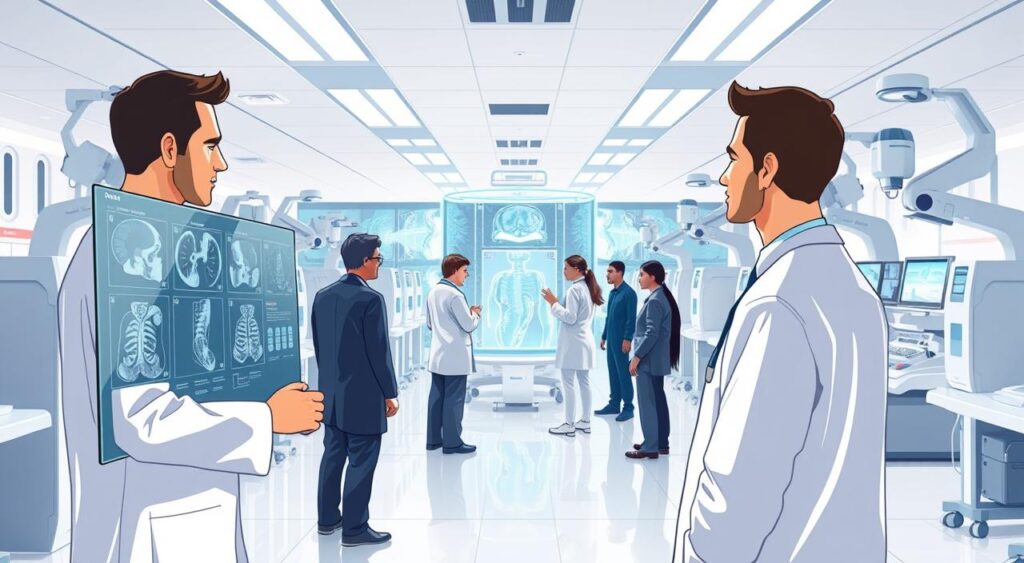
Precision Diagnostics in Radiology and Beyond
The FDA-approved IDx-DR system exemplifies precision diagnostics in action. This technology achieves 87% sensitivity and 90% specificity for detecting vision-threatening diabetic retinopathy. Medicare reimbursement validates its clinical utility for preventing blindness.
Twenty-two unique machine learning technologies assist with stroke and intracranial hemorrhage detection. They analyze brain imaging in minutes, alerting specialists faster than traditional workflows. This rapid intervention can save brain tissue and lives.
Radiotherapy planning benefits from automated tumor segmentation. These algorithms handle tasks that traditionally required hours of manual work by radiation oncologists. The result is more precise cancer treatment targeting.
Ongoing research expands diagnostic capabilities beyond imaging. Systems now analyze genetic information to guide cancer treatment selection. They integrate multiple data sources for comprehensive assessments that consider more variables than human physicians can process simultaneously.
Integrating AI for Cost Containment and Patient Affordability
Financial barriers continue to challenge millions seeking medical services across the United States. With one-third of Americans finding their care unaffordable and 44% delaying necessary treatment due to cost constraints, innovative solutions are urgently needed.
Advanced computational systems provide unprecedented opportunities to address these economic pressures while maintaining quality outcomes. These approaches focus on prevention and personalization to reduce long-term expenses.
Preventive and Personalized Care Solutions
Machine learning algorithms analyze electronic health records and demographic information to identify high-risk individuals before chronic conditions develop. This enables early interventions that prevent costly emergency treatments.
Personalized approaches consider genetic makeup, lifestyle factors, and environmental exposures to create tailored treatment plans. This precision medicine avoids the trial-and-error approach that wastes resources on ineffective therapies.
Remote Monitoring and Telehealth Innovations
The COVID-19 pandemic accelerated adoption of virtual care platforms that reduce facility visits. Wearable sensors continuously track vital signs for chronic condition management, alerting providers to concerning changes before crises occur.
Smartphone applications assess symptoms and provide guidance without office visits. This remote monitoring significantly reduces hospital admissions and emergency room visits, particularly for patients with heart failure and COPD.
World Economic Forum research demonstrates that digital health tools empower community workers to identify care gaps and intervene before problems escalate into costly emergencies.
These innovations create a sustainable model where patients receive more accessible care, providers deliver more effective treatments, and payers reduce expenditures on preventable complications.
Innovative Use Cases and Future Trends in AI Healthcare
Next-generation computational systems are poised to revolutionize every facet of medical practice in the coming decade. The landscape of intelligent health solutions is expanding beyond current diagnostic applications into comprehensive care transformation.
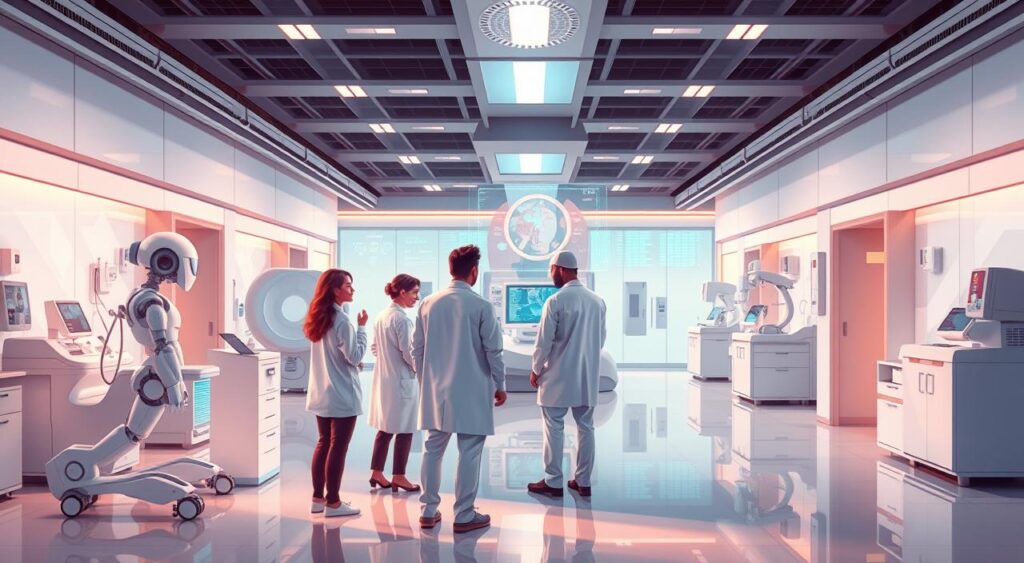
Emergent AI Applications in Patient Care
Within five years, we’ll see virtual assistants providing personalized mental health support and IoT-connected wearables monitoring chronic conditions. These technologies are already entering clinical practice with remarkable potential.
Medium-term innovations will leverage multi-modal data integration. Ambient intelligence systems will passively monitor patients in their homes. Robotic-assisted therapies will enhance physician capabilities and outcomes.
Dr. Ravi B Parikh predicts significant integration within 5-10 years. He states this technology will become as fundamental as electronic health records are today.
“Within the next 5 to 10 years, we are going to see AI become integrated into health care to the same extent as electronic health records were once integrated.”
Long-term possibilities include autonomous virtual assistants providing predictive care. Networked organizations will share intelligence across single digital infrastructure. Genomics-driven personalized treatments will become standard.
Generative artificial intelligence shows particular promise for reducing administrative burdens. It can automate clinical documentation and patient communication. This allows medical professionals to focus more on direct care.
Research explores innovative monitoring like wireless sensors tracking sleep and breathing. Smart speakers may detect heart rhythm abnormalities. These advances make continuous health monitoring seamless in daily life.
The future points toward proactive health optimization rather than reactive disease treatment. Intelligent systems will predict individual risk and personalize prevention strategies. This creates a fundamentally more effective model of medicine.
Expert Insights and Industry Perspectives on AI in Medicine
The perspectives of technology executives and medical experts provide crucial guidance for organizations navigating the integration of intelligent medical technologies. These authoritative voices highlight both the tremendous potential and practical considerations for implementation.
Perspectives from Leading Technology Executives
Microsoft CEO Satya Nadella emphasizes the transformative nature of this technology, stating, “AI is perhaps the most transformational technology of our time, and healthcare is perhaps AI’s most pressing application.” This sentiment reflects the strategic importance major companies place on medical innovation.
Apple’s Tim Cook recognizes the economic significance, noting that medical activity represents one of the largest components of the American economy. Google Health envisions assistive technologies that empower doctors to better serve their patients through machine learning applications.
Overcoming Clinical Adoption Challenges
Dr. Ravi B Parikh provides practical insights about real-world implementation. He notes that FDA-approved technologies for stroke detection can alert radiologists faster than traditional processes. Generative artificial intelligence shows promise for reducing administrative burdens.
However, adoption challenges persist. Dr. Parikh explains, “Recent evidence has demonstrated that many FDA-approved reimbursable AI tools tend to be dominated by larger academic health systems.” Smaller centers often face barriers like expensive contracts and infrastructure requirements.
Cloud computing infrastructure helps address these challenges by providing accessible computational capacity. This enables smaller organizations to analyze large data amounts at reasonable costs. The technology is expected to become as fundamental as electronic health records within 5-10 years.
Conclusion
We stand at a pivotal moment where computational medicine is transitioning from theoretical promise to tangible clinical reality. The evidence demonstrates this represents a fundamental transformation in how we approach healthcare delivery.
These intelligent systems are already enhancing diagnostic accuracy and personalizing treatments. They address long-standing challenges in access and affordability. The technology amplifies human expertise rather than replacing it.
Successful implementation requires thoughtful design and rigorous validation. Ongoing collaboration between technology innovators and medical professionals ensures these tools integrate seamlessly into clinical workflows.
Looking ahead, this evolution promises better health outcomes for more people at sustainable costs. The shift toward proactive, predictive care represents the future of American medicine.
Artificial intelligence in healthcare is not a distant possibility but a present reality delivering measurable benefits today.
